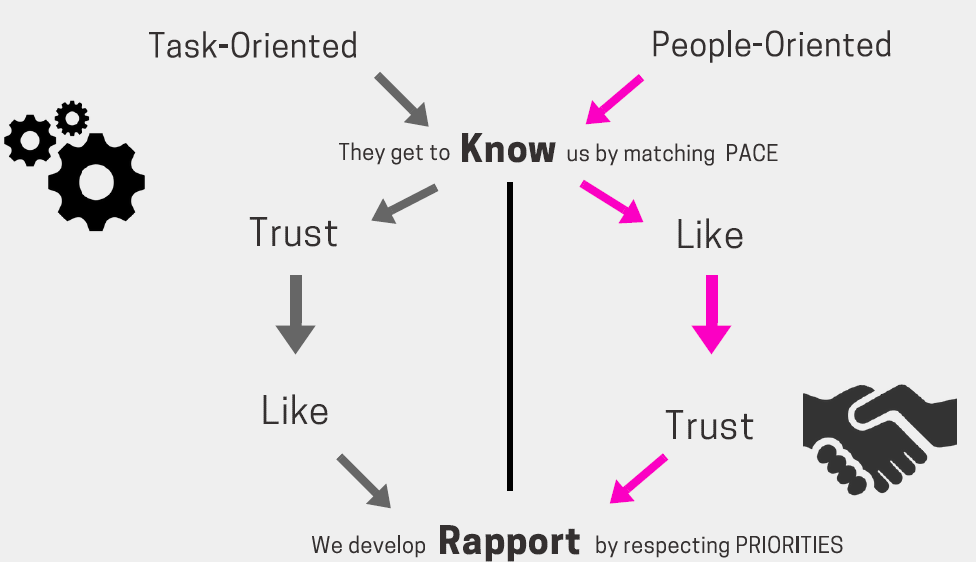What is Rapport?
Rapport is the deepest level of relationship between two individuals that involves sharing common ground, and is established when harmony and accord have been reached between both parties. This does not mean the individuals involved agree on every issue. Instead, it means they have attained a mutual respect for each other’s opinions. Developing rapport with others lowers stress within our relationships, thereby creating greater productivity.
We have established rapport with people know, like and trust
Establishing Rapport
Rapport is developed as we understand, recognize, appreciate, and adapt to the behavior and communication styles of others. Regardless of background, everyone wants to be valued, appreciated and unconditionally accepted for who they are. As a result, we tend to trust and have an affinity for the people we believe really understand us and accept us.
Unfortunately, we struggle with this as human beings. Some folks just ʻrub us the wrong wayʼ, or worse still, they ʻpush our buttonsʼ. And often, the ones that irritate us the most are the ones closest to us, such as family, friends, and coworkers.
To begin connecting with others, we must cultivate a genuine desire to understand the people around us.
Mastering Rapport
Mastering rapport is reached when an individual develops the skills and the genuine desire to develop relationships of mutual trust and emotional affinity.
Rapport Mastery™ works best when adopted as a lifestyle to better communicate with people and do business, not merely to manipulate others with surface techniques or to be saved until there is a glaring problem. Rapport Mastery™ involves personal transparency as well as enthusiasm for the success of others.
The Road to Rapport
There is no instant path to building rapport with those around us. This level of respect and trust will take time to develop. Attempting to rush this process will actually be counterproductive as it breaks that trust. Although each of us will have the ability to connect more quickly with certain individuals, there is no way to create this level of trust and regard for another person outside of the test of time. Creating rapport is a step by step process.
Do I Have Rapport?
Individuals with whom you have established rapport will come to you for advice or information on a wide variety of subjects. Rapport is developed as we understand, recognise, appreciate, and adapt to the behaviour and communication styles of others.
How do you begin to establish rapport?’
The Power of Perception
Rapport starts with understanding the behavioural and communication style of another, discovering how our personal actions are being perceived by others, and learning to control our own behaviours to better meet their needs.Connecting with others begins with recognising and understanding the perception of those with whom we interact.
Humans are uniquely different from one another. Our ideas about the world around us have been influenced by our parents, values, education, and culture. In addition to these factors, the way we perceive, interpret and share this information is based largely upon our behavioural and communication style.
Imagine that two individuals walk into a room. Both are wearing glasses, however one pair has red lenses and one has blue. Neither of them realise they have glasses of different colours. Both individuals are asked to look at a white wall and announce to the other what colour they believe the wall to be. The individual wearing the red glasses will be sure the wall is red, while the individual with the blue lenses will be sure it’s blue. They both would KNOW they were correct and sure the other person was wrong.
Now imagine these individuals try on each other’s glasses. Would they have a better idea of what the other person was seeing? This change of perception would help reduce conflict because each of them would now be able to understand the otherʼs perception.
In order to understand and connect, we need to understand how the other person is perceiving the world around them. By putting on someone else’s glasses, so to speak, we will have the ability to appreciate and understand them better.
Perception is based on an individual’s communication and behavioural style
Pace, Perception and Adaption
To understand human behaviour and communication we need to begin by looking at two basic elements pace and priority.
Pace is the speed at which individuals move and speak. Some individuals tends to be more faster or slower than others. There is not right or wrong pace as we all have elements of both.
Fast paced individuals tend to move, speak, respond and decide quickly, whereas sower paced individuals prefer to spend time in reflection and act carefully.
If you are fast paced person, a slower paced individual may see you as impatient, irresponsible, reckless, rude, manipulative, overbearing, angry and inconsiderate.
If you are a slow paced person, a fast paced individual may see you as unmotivated, lazy, sad, uncaring, disrespectful, disengaged, untruthful and distracted.
All relationships being by connecting with each other’s PACE. If there is missed connection at his level, you will be unable to move forward to build rapport.
This is where adaption comes into play. Connecting in a non-confrontational, non-irritating way requires adapting my own pace to match the pace of the other person. I may be fast paced, however, the only way to show the slow paced person that I am not impatient or reckless, I must control my actions and slow down. In the same way, if I am slow paced, I may need to speed up my interactions so I am not perceived as unmotivated and lazy.
Priority characteristics
As with pace, individuals have different priorities , which refer to what they prioritise as they view their world. Individuals tend to be either:
Task-Orientated – they are more focused on accomplishing tasks. Think in terms of plans, procedures, organisation, function, projects and programs. They like to create lists and check off items as they ate completed.
People-Orientated – they are more focused on establishing relationships. They are energized by being around people. They tend to focus on more on relationships, feelings, friendships, helping others and making people happy.
If you are a task-orientated person, a people-orientated person may perceive you as cold, workaholic, greedy, disconnected, inflexible, unmerciful, unfriendly and not family oriented.
If you are a people-oriented person, a task-oriented individual may perceive you as distracted, weak, overly emotional, unproductive, naive, gullible, foolish and not serious.
90% of conflict is caused by a clash of priorities or false perceptions
Now that we understand what rapport is and how we unknowingly can break it by failing to control our behaviour, we can now develop a process that will help us to better adapt and build relationships.
Know, Like, & Trust
Remember, rapport is established with all types of individuals when they know, like, and trust you. Matching pace provides the foundation for rapport by allowing other’s to get to know us.
However, the other two aspects, trust and like, are developed differently depending upon an individual’s priority style.
We get to know each other by matching pace. We develop rapport by respecting priorities.
Task-oriented individuals must trust you before they will like you. Here’s the progression of establishing rapport with the task-oriented individual: They will do business with you only if they have come to trust you. Once trust is established they will gradually begin to like you.
People-oriented individuals must like you before they will trust you. Here’s the progression of establishing rapport with the people-oriented individual: They must first like you. (One of the best ways to begin to establish affinity with this type is to smile.) Once they like you
they will begin to trust and develop rapport with you.
2 ROADS TO RAPPORT

Practical Application
To build rapport with a task-oriented individual, consider what is most important to this behaviour style. Because this behaviour style views the world from a task perspective, task completion is imperative for constructing trust.
Do’s to initiate affinity
- Arrive early to appointments.
- Promptly return phone calls.
- Get down to business quickly.
- Do what you say you will.
- Focus on logical results.
Don’ts
- Over promise and under deliver.
- Let your attention wander.
- Be too emotional.
- Ask them how they feel.
- Tell stories or jokes.
To build rapport with a people-oriented individual, consider what is most important to this behaviour style. Because this behaviour style views the world from a people perspective, they will observe how you interact with others and desire friendship.
Do’s to initiate affinity
- Be kind & patient.
- Let them talk & tell stories.
- Smile & be amiable.
- Set aside ample time.
- Relax & enjoy the meeting.
Don’ts
- Bully or be overbearing.
- Get right down to business.
- Rush them.
- Interrupt while they’re talking.
- Be unresponsive.
They are the basics of building more meaningful, peaceful, and productive relationships with those around you.


































